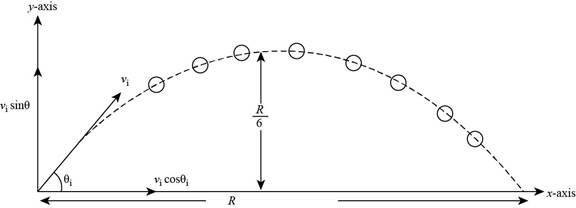
Concept explainers
A ball is thrown with an initial speed υi at an angle θi with the horizontal. The horizontal range of the ball is R. and the ball reaches a maximum height R/6. In terms of R and g, find (a) the time interval during which the ball is in motion, (b) the ball’s speed at the peak of its path, (c) the initial vertical component of its velocity, (d) its initial speed, and (e) the angle θi, (f) Suppose the ball is thrown at the same initial speed found in (d) but at the angle appropriate for reaching the greatest height that it can. Find this height. (g) Suppose the ball is thrown at the same initial speed but at the angle for greatest possible range. Find this maximum horizontal range.
(a)
The time interval during which the ball is in motion.
Answer to Problem 4.56AP
The time interval during which the ball is in motion is
Explanation of Solution
Given info: The initial speed of the ball is
The motion of the ball follows the parabolic path and the ball is said to projectile, the motion of the ball is shown in the Figure below.

Figure (1)
The formula to calculate the maximum height reached by the projectile is,
Here,
Rearrange the above equation.
Substitute
Thus, the vertical component of the initial velocity is
The formula to calculate the time taken by the ball to reach the ground is,
Here,
Substitute
Conclusion:
Therefore, the time interval during which the ball is in motion is
(b)
The speed of the ball at the peak of its path.
Answer to Problem 4.56AP
The speed of the ball at the peak of its path is
Explanation of Solution
Given info: The initial speed of the ball is
From part (a) the time of flight is
From the Figure (1) the range of the ball and time of flight is,
Rearrange the above equation.
Substitute
Conclusion:
Therefore, the speed of the ball at the peak of its path is
(c)
The initial vertical component of the velocity.
Answer to Problem 4.56AP
The initial vertical component of the velocity is
Explanation of Solution
Given info: The initial speed of the ball is
From part (a) vertical component of the initial velocity is
Conclusion:
Therefore, the initial vertical component of the velocity is
(d)
The initial speed of the ball.
Answer to Problem 4.56AP
The initial velocity of the ball is
Explanation of Solution
Given info: The initial speed of the ball is
From part (a) vertical component of the initial velocity is,
Square both side of the above equation.
And from part (b) the horizontal component of the velocity is
Square both side of the above equation.
Add equation (1) and (2) to find the initial velocity.
Conclusion:
Therefore, the initial velocity of the ball is
(e)
The angle
Answer to Problem 4.56AP
The angle
Explanation of Solution
Given info: The initial speed of the ball is
From part (a) vertical component of the initial velocity is,
And from part (b) the horizontal component of the velocity is
Take the ratio of the horizontal component and the vertical component of the initial velocity.
Conclusion:
Therefore, the angle
(f)
The maximum height that the ball can reach with the same initial velocity.
Answer to Problem 4.56AP
The maximum height that the ball can reach with the same initial velocity is
Explanation of Solution
Given info: The initial speed of the ball is
For the maximum height to be gained by the ball the angle made by the horizontal should be
The formula to calculate the maximum height reached by the projectile is,
Here,
Rearrange the above equation.
From part (d) the initial velocity of the ball is,
Substitute
Conclusion:
Therefore, the maximum height that the ball can reach with the same initial velocity is
(g)
The maximum range of the ball with the same initial velocity.
Answer to Problem 4.56AP
The maximum range of the ball with the same initial velocity is
Explanation of Solution
Given info: The initial speed of the ball is
For the maximum range to be gained by the ball the angle made by the horizontal should be
The formula to calculate the maximum height reached by the projectile is,
Here,
From part (d) the initial velocity of the ball is,
Substitute
Conclusion:
Therefore, the maximum range of the ball with the same initial velocity is
Want to see more full solutions like this?
Chapter 4 Solutions
Physics For Scientists And Engineers, Volume 2, Technology Update
- If a projectile is fired from the origin of the coordinate system with an initial velocity υ0 and in a direction making an angle α with the horizontal, calculate the time required for the projectile to cross a line passing through the origin and making an angle β < α with the horizontal.arrow_forwardOn a spacecraft two engines fire for a time of 389 s. One gives the craft an acceleration in the x direction of ax = 3.41 m/s^2, while the other produces an acceleration in the y direction of ay = 7.34 m/s^2. At the end of the firing period, the craft has velocity components of vx = 1860 m/s and vy = 4290 m/s. Find the (a) magnitude and (b) direction of the initial velocity. Express the direction as an angle with respect to the +x axis.arrow_forwardFrom the window of a building, a ball is tossed from a height y0 above the ground with an initial velocity of 8.60 m/s and angle of 18.0° below the horizontal. It strikes the ground 5.00 s later. (a) If the base of the building is taken to be the origin of the coordinates, with upward the positive y-direction, what are the initial coordinates of the ball? (Use the following as necessary: y0.) xi = 0 yi = γ0 (b) With the positive x-direction chosen to be out the window, find the x- and y-components of the initial velocity. vi,x = m/s vi,y = m/s (c) Find the equations for the x- and y- components of the position as functions of time. (Use the following as necessary: y0 and t. Let the variable t be measured in seconds.) x = m y = m (d) How far horizontally from the base of the building does the ball strike the ground? m(e) Find the height from which the ball was thrown. m(f) How long does it take the ball to reach a point 10.0…arrow_forward
- A particle initially located at the origin has an acceleration of = 2.00ĵ m/s2 and an initial velocity of i = 9.00î m/s. (a) Find the vector position of the particle at any time t (where t is measured in seconds).( t î + t2 ĵ) m(b) Find the velocity of the particle at any time t.( î + t ĵ) m/s(c) Find the coordinates of the particle at t = 5.00 s.x = my = m(d) Find the speed of the particle at t = 5.00 s. m/sarrow_forwardA fireworks show is choreographed to have two shells cross paths at a height of 154 feet and explode at an apex of 191 feet under normal weather conditions. If the shells have a launch angle θ = 56° above the horizontal, determine the common launch speed v0 for the shells, the separation distance d between the launch points A and B, and the time t from the launch at which the shells explode.arrow_forwardA rugby player runs with the ball directly toward his opponent’s goal, along the positive direction of an x axis. He can legally pass the ball to a teammate as long as the ball’s velocity relative to the field does not have a positive x component. Suppose the player runs at speed 4.0 m/s relative to the field while he passes the ball with velocity relative to himself. If has magnitude 6.0 m/s, what is the smallest angle it can have for the pass to be legal?arrow_forward
- if the marble is launched with the launch speed V_{o} but at an initial angle of , what would be the expression of v_{0} in terms of horizontal displacement x and vertical displacement y? Hint: y = (v_{0} * sin theta) * t - 1/2 * q * t ^ 2 and replace t using x = (v_{0} * cos theta) t .arrow_forwardMiltiadis Tentoglou is the current Olympic gold medalist for the running long jump. In one of Miltiadis’ practices, he insanely attempts to jump five people who are laid out on the ground in single file from head to toe. Each of the five individuals are 1.7 meters in height and when Miltiadis launches off the ground his initial resultant velocity is directed 20 degrees above the horizon and the horizontal component of this resultant velocity is 10 m/s. In executing the jump, Miltiadis’ center of mass drops 0.6 meters vertically from the instant of takeoff to the instant of landing. Calculate Miltiadis’ a) initial and final vertical velocities in m/s, b) initial and final resultant velocity magnitudes in m/s, c) total time in the air in seconds and d) how far he was able to jump horizontally in meters. e) How many centimeters of clearance did Miltiadis have on both sides of the jump when jumping the five individuals (assume the clearance distance is the same on both sides of the…arrow_forwardA cannon ball is fired with an initial speed of 123 m/s at angle of 60 degrees from the horizontal. Express the initial velocity as a linear combination of its unit vector components. ( m/s) + ( m/s) At the maximum height, the speed of the cannon ball is v = ? m/s and the magnitude of its acceleration is a = ? m/s2. The time needed to reach maximum height is t = ? s. The maximum height reached by the cannon ball is H = ? m.arrow_forward
- A projectile is fired with an initial speed of 40 m/s at angle of 23 degrees above the horizontal on a long flat firing range. Determine (1) the maximum vertical distance reached by the projectile, (2) the total time in the air, (3) the range of the projectile, (4) the velocity of the projectile 2 s after firing.arrow_forwardA projectile is launched with a launch angle of 30° with respect to the horizontal direction and with an initial speed of 26 m/s. How do the vertical and horizontal components of the projectile's velocity vary with time?The initial velocity in the x-direction vx0 is related to the initial speed by vx0 = v0 cos 30°. The constant velocity in the x-direction means that the equation describing the time dependence of x for the particle, with x0 taken as 0, is x = x0 + vx0t = 0 + m/s t. The equation for the vertical coordinate, which is constantly accelerating downward at g = 9.8 m/s2, is y = y0 + vy0t − 1 2 gt2 = m/s t + m/s2 t2.arrow_forwardConsider a projectile launched form ground level at an angle of elevation with an initial velocity . The maximum horizontal range is given by xmax=(v 2/0 sin2θ)/g, where g is the acceleration due to gravity. Here is the problem: If a soccer ball is kicked from ground level with an initial velocity of 28 m/sec, what is the smallest positive angle at which the player should kick the ball to reach a teammate 48m down the field? Assume that the ball reaches the teammate at ground level on the fly. Round to the nearest tenth of a degree.arrow_forward
 Classical Dynamics of Particles and SystemsPhysicsISBN:9780534408961Author:Stephen T. Thornton, Jerry B. MarionPublisher:Cengage Learning
Classical Dynamics of Particles and SystemsPhysicsISBN:9780534408961Author:Stephen T. Thornton, Jerry B. MarionPublisher:Cengage Learning Principles of Physics: A Calculus-Based TextPhysicsISBN:9781133104261Author:Raymond A. Serway, John W. JewettPublisher:Cengage Learning
Principles of Physics: A Calculus-Based TextPhysicsISBN:9781133104261Author:Raymond A. Serway, John W. JewettPublisher:Cengage Learning

